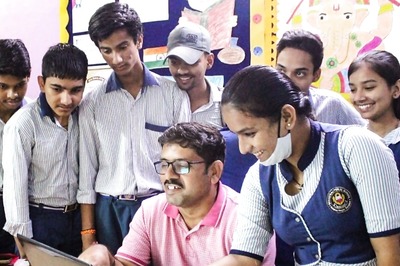
views
My RT-PCR report has come negative. But there are chances that I could still be positive. So says the good doctor. He has highly recommended getting a second test done before I show up in our beleaguered newsroom, which is facing a reduced troop strength owing to the second wave.
By now, all of us have heard of the false negative. You feel unwell and get tested. Your report comes negative. But then you develop symptoms four days later and are found to be positive.
It has happened in a cousin’s family. Her 22-year-old son came down with high fever. Certain that it’s Covid-19, he was quarantined and underwent the test. He was negative. Probably a viral fever. Life was back to normal. Until the rest of the family developed fever. My cousin experienced extreme exhaustion a few days later. Another round of testing. All four in the family, including the 22-year-old, tested positive.
Many families I know in Lucknow and Delhi are reporting the mysterious case of false negatives. A recent report in the Times of India said one in five RT-PCR tests are throwing up a false negative. But how did this happen? Isn’t RT-PCR — its full form is reverse transcription polymerase chain reaction — considered gold-standard? Has the virus mutated in a way that it is fooling RT-PCR, as claimed by some media reports?
The central government said on Friday that RT-PCR tests done in India do not miss the “UK, Brazil, South Africa and Double Mutant variants” of the SARS-CoV-2 virus, which causes Covid-19.
Dr Raman Gangakedkar, an epidemiologist of international repute and the face of Covid briefings of the Indian Council of Medical Research (ICMR) before he retired, too, dismissed the mutant theory. “So far there is no data or study anywhere in the world that shows any variant evolving enough to beat the RT-PCR test. But there is enough evidence to show how shoddy swabbing and sample collection can impact testing,” Gangakedkar said.
Dr Sahid Jameel, a virologist heading the school of biosciences at Ashoka University, agreed. “Many people who are sent for swab collection are simply not trained. And that is my worry. That is where things go wrong,” Jameel said.
In testing, timing is important. You test too early or too late in the infection cycle, you could miss it. That could be another factor driving up false negatives, Gangakedkar said.
According to experts, a close interaction/contact with an infected person is an exposure. A symptomatic person can give you the infection with just one cough of sneeze. Hence, masks and social distancing are important. “You qualify as a close contact…if you have been exposed to a Covid positive person (typically) two days before to 10 days after the onset of the person’s illness,” Dr Trupti Gilada said from Mumbai over the phone.
“In most cases, the incubation period for the virus is 5-14 days. Symptoms usually start showing up in a week’s time. So the best time to take an RT-PCR test would be on the seventh day of the exposure. Even if you are asymptomatic, the test should be taken before the end of the week of the exposure. Anytime earlier and there is a good chance that RT-PCR may miss it,” Gilada explained.
While the symptoms may come 5-10 days after catching the infection, the virus is most contagious 48-72 hours before the symptoms show. So as soon as you are exposed, quarantine yourself (isolation is a word used for those who test positive).
A typical infection can last up to 14 days after the exposure. “On the safe side, a week after you test negative and experience no symptoms,” Gilada said.
In Mumbai, the two hospitals where Gilada is a consultant, are seeing a rush of Covid-19 patients once again. Beds have run out. People are on waitlists. So are doctors like her seeing an uptick in the number of false negatives?
“Not really. It is as much as in the first wave. We know the RT-PCR test will miss 30% of the cases, and that is how it is playing out. Come to think of it, 60% of cases in Maharashtra are being driven by the new mutant/variant. If it had developed a mechanism to beat the RT-PCR, how would our positivity rate be as high as 20%?” she asked.
Positivity rate is the percentage of people found positive for the virus among those who have been tested. So, if one out of five people is testing positive in the city, it means that RT-PCR is picking up the Indian mutant, she explained.
One of India’s leading epidemiologists, Dr J Muliyal, said false negatives, and not false positives, were the real issue. “In the last one year, there have been many many cases of people who didn’t have Covid testing positive. The curse of the RT-PCR test is that it is not insensitive, but that it is too sensitive to a point that it loses out on specificity,” he said.
I will take a second RT-PCR test anyway. Just to be sure.
Read all the Latest News, Breaking News and Coronavirus News here. Follow us on Facebook, Twitter and Telegram.




















Comments
0 comment